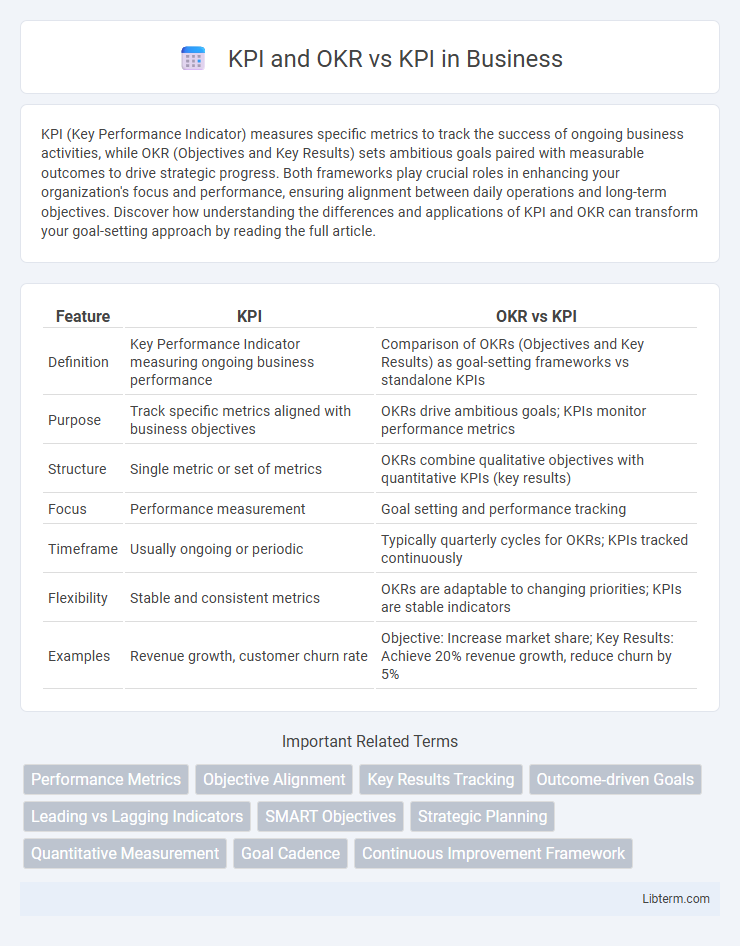KPI (Key Performance Indicator) measures specific metrics to track the success of ongoing business activities, while OKR (Objectives and Key Results) sets ambitious goals paired with measurable outcomes to drive strategic progress. Both frameworks play crucial roles in enhancing your organization's focus and performance, ensuring alignment between daily operations and long-term objectives. Discover how understanding the differences and applications of KPI and OKR can transform your goal-setting approach by reading the full article.
Table of Comparison
| Feature | KPI | OKR vs KPI |
|---|---|---|
| Definition | Key Performance Indicator measuring ongoing business performance | Comparison of OKRs (Objectives and Key Results) as goal-setting frameworks vs standalone KPIs |
| Purpose | Track specific metrics aligned with business objectives | OKRs drive ambitious goals; KPIs monitor performance metrics |
| Structure | Single metric or set of metrics | OKRs combine qualitative objectives with quantitative KPIs (key results) |
| Focus | Performance measurement | Goal setting and performance tracking |
| Timeframe | Usually ongoing or periodic | Typically quarterly cycles for OKRs; KPIs tracked continuously |
| Flexibility | Stable and consistent metrics | OKRs are adaptable to changing priorities; KPIs are stable indicators |
| Examples | Revenue growth, customer churn rate | Objective: Increase market share; Key Results: Achieve 20% revenue growth, reduce churn by 5% |
Understanding KPIs: Definition and Purpose
Key Performance Indicators (KPIs) are specific, measurable metrics used to evaluate the effectiveness of an organization, team, or individual in achieving strategic objectives. KPIs provide a clear quantifiable benchmark that guides business decisions and tracks progress over time. Unlike OKRs (Objectives and Key Results), which emphasize ambitious goal-setting and qualitative outcomes, KPIs focus primarily on consistent performance measurement and operational efficiency.
What Are OKRs? Key Components Explained
OKRs (Objectives and Key Results) are a goal-setting framework designed to align team objectives with measurable outcomes, enhancing organizational focus and performance. Key components include clear, ambitious Objectives that define what needs to be achieved, and quantifiable Key Results that track progress with specific metrics. Unlike traditional KPIs that monitor performance, OKRs drive strategic priorities by setting goals that challenge and engage teams while providing transparency and accountability.
KPI vs OKR: Core Differences
KPI (Key Performance Indicator) measures specific, quantifiable metrics to track progress against set targets, typically focusing on ongoing performance monitoring. OKR (Objectives and Key Results) defines ambitious objectives and measurable key results aimed at driving strategic initiatives and innovation. The core difference lies in KPIs tracking operational efficiency and stability, while OKRs emphasize goal-setting and transformational growth within an organization.
When to Use KPIs vs OKRs
KPIs (Key Performance Indicators) measure specific performance metrics critical for ongoing operational success, making them ideal for tracking established targets and maintaining business health. OKRs (Objectives and Key Results) focus on ambitious, qualitative goals paired with measurable outcomes, best suited for driving strategic initiatives and fostering innovation. Use KPIs for continuous performance monitoring and OKRs during goal-setting phases to align teams on transformative priorities.
Advantages of Combining OKRs with KPIs
Combining OKRs (Objectives and Key Results) with KPIs (Key Performance Indicators) aligns strategic goals with measurable performance metrics, enhancing overall productivity and focus. OKRs drive ambitious goal-setting and innovation, while KPIs provide clear, data-driven benchmarks for progress tracking and operational efficiency. This integration fosters transparency, accountability, and continuous improvement, enabling organizations to adapt swiftly to changing market conditions.
KPI Examples Across Industries
Key Performance Indicators (KPIs) are specific, quantifiable metrics used to evaluate the success of an organization or particular activities, with examples varying widely across industries such as customer retention rates in retail, production efficiency in manufacturing, and lead conversion rates in sales. Unlike Objectives and Key Results (OKRs), which combine qualitative objectives with key measurable outcomes to drive ambitious growth initiatives, KPIs focus solely on tracking ongoing operational performance. Common KPI examples include net promoter score (NPS) for customer satisfaction, average resolution time for IT support, and gross profit margin in finance, each tailored to deliver actionable insights within their respective sectors.
OKR Examples for Business Growth
OKRs (Objectives and Key Results) differ from traditional KPIs by aligning measurable outcomes with strategic business goals, driving focused growth. A clear OKR example for business growth is setting an objective like "Increase quarterly revenue by enhancing customer retention," paired with key results such as "Achieve a 15% increase in recurring sales," "Reduce churn rate to below 5%," and "Launch 3 customer loyalty programs." This structured approach transforms broad KPIs into actionable milestones, accelerating performance and scaling business success.
Common Pitfalls: OKRs Replacing KPIs
Confusing OKRs with KPIs often leads to neglecting steady performance measurement, as OKRs focus on ambitious goal-setting while KPIs track ongoing operational health. Common pitfalls include replacing KPIs entirely with OKRs, causing loss of vital baseline metrics and undermining consistent performance monitoring. Maintaining both frameworks ensures dynamic progress through OKRs and reliable measurement via KPIs, preventing strategic misalignment and performance gaps.
Integrating KPI and OKR Frameworks
Integrating KPI and OKR frameworks enhances organizational performance by aligning measurable outcomes with strategic objectives, ensuring clarity in goal tracking and accountability. KPIs provide quantifiable metrics to monitor ongoing operational efficiency, while OKRs set ambitious, time-bound goals fostering innovation and growth. Combining these approaches creates a holistic performance management system that drives both execution and transformational success.
Choosing the Right Approach: KPI, OKR, or Both?
Selecting the right performance management approach depends on organizational goals; KPIs (Key Performance Indicators) measure ongoing operational efficiency with specific metrics, while OKRs (Objectives and Key Results) drive ambitious, goal-oriented outcomes through qualitative objectives paired with quantifiable results. Companies aiming for steady performance tracking benefit from KPIs, whereas those pursuing innovation and transformational change rely on OKRs to align teams towards strategic priorities. Integrating both frameworks enables comprehensive monitoring of current performance and progress toward strategic goals, optimizing overall business success.
KPI and OKR Infographic

 libterm.com
libterm.com